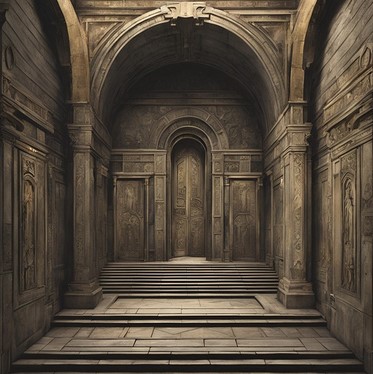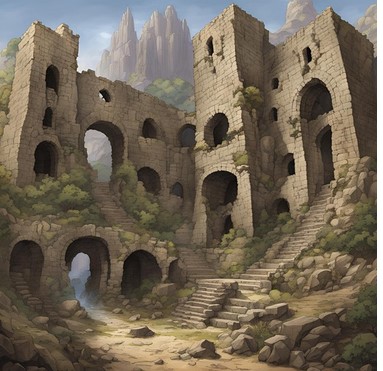The stairs leading up to the raised structure of the Mausoleum proper is at its widest a rectangle of 120 feet (24 squares) by 90 feet (18 squares). 24 steps lead upwards and inwards towards what could be called the first floor, where the platform upon which the upper chamber, guarded by its grand wooden doors, stands ringed by aforementioned Tyrian pillars. Between each pillar is the image of a god, cast in bronze and dressed in garments of silk in a rainbow of colors. Unlike most depictions of the gods, which have them solemnly standing with symbols of their power, these gods are visibly frightened, bowing in reverence toward the building or recoiling away from it. Practitioners of the Cultus Deorum will recognize the Greek variants of Iuppiter, Neptunus, Dispater, and so on demonstrating obeisance on their knees, faces contorted in the fear one might only see in children before a snarling wolf. Only one goddess does not seem to be cowed, one who looks similar to Hecate (for those familiar) but not depicted as she ever was. She wears the radiate diadem of kings, and her finger is pointed toward the door in the clear sign of spellcasting.
“The doors have no handle, and do not respond to pushing. Though they appear to be made of wood, they feel as if made of stone.”
This begins the first puzzle the party will have to solve; getting into the tomb itself. The quick-minded adventurer will recognize that there is something special about the Hecate statue. If they search the statue, they won’t find any sign of levers, buttons, or anything that would mechanically control the doors. However, the Detect Magic spell heightened to 4th level will reveal that the statue is radiating with powerful magic. The creative adventurer will attempt to smash the statue, which is the answer to the puzzle. The statue will crumble away without too much forceful bashing, and the doors will crack in a web pattern, eventually shattering into splinters. Thus is the way open into the first room.
“The walls are etched in epic poetry in three languages; the ancient ancestor of Greek, the ancient ancestor of Persian, and a third language not similar to any common tongue spoken today.”
Any PC who knows both Greek and Persian may attempt to decipher the poetry. They will only be able to a small portion, where it is continuously Greek and Persian without any Carian between them (the former language of Caria, of which Halicarnassus was the capital of. Carian and other Luwic languages have not been spoken in hundreds of years.) The passage available to them reads as follows:
“I am the one who tasted ambrosia. I wear the crown of Ethyra upon my head. I stand alone in the ranks of kings. Those before me and after me prostrate before my form. Those before me have died so that I may achieve. Those after me will die in the study of what I have achieved. Know this, you shall not mimic me. I am Mausolus, never claimed by Thanatos.”
A PC speaking the poem aloud will cause it to shift, bowing inwards like a portal and revealing the room behind it. It is featureless, grey, and without any furniture, adornments, or designs. Any magic user who crosses the threshold will be Sickened 1, as they will be suddenly struck with a powerful headache and nausea. The observant player may note that there is no space behind the previous chamber for this one to exist in. If the players climb through, the portal will close behind them, trapping them in the room. Speaking the poem again verbatim will open the portal again, allowing them to return to the first room, but for a moment as the portal is opening a flash will appear on the walls in Doric Greek, saying the following: “Morning succeeds midday succeeds evening succeeds night.” The secret, here, is to repeat the poem word for word backwards in the previous more adorned room. Should they do so, the plain stone floor beneath them will reveal itself to be a large tapestry rug with a clever visual illusion. They will feel as if they were standing on solid ground, but looking down, their eyes may convince them that they are hovering over where a stairway leads down into a dark chamber below. In fact, it appears as if there are a great many stairways downward, of various sizes and tiled together like marble blocks. This is the work of dyes and artistry; thus, players will not be allowed to disbelieve it. The largest stair-like rug is in the middle, around which the others almost seem to spiral. This is a mimic. The moment a PC attempts to step onto one of its steps, it will wrap itself around the leg of said PC and initiate combat. The correct one is a smaller stairway tucked in the far northeast, which is an actual stairway and not a rug, and will lead down into the lower rooms.

